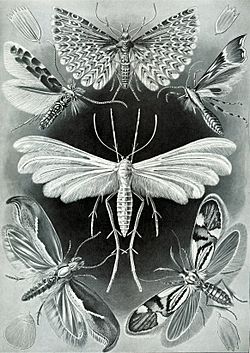Micromoth facts for kids

Micromoths are a group of very small moth families. They are super common but much tinier than the butterflies and larger moths you might know. Their wings usually spread less than 20 millimeters wide. This makes them quite hard to spot and identify!
Micromoths have some unique ways of life compared to bigger moths. The term 'micromoth' is just a handy way to group them. It's not a scientific family, but it helps us tell them apart from 'macrolepidoptera', which are the larger types.
Even though they are small, some micromoths fly during the day, just like butterflies. Thanks to modern digital macrophotography, it's now much easier to take close-up pictures of them. This helps scientists and enthusiasts identify these tiny creatures better.
Contents
What are Micromoths?
Micromoths are basically mini-moths. They are part of the larger group called lepidoptera, which includes all moths and butterflies. The main thing that makes them "micro" is their size. They are often so small that you might not even notice them flying around.
Tiny but Mighty: Their Size
Imagine a moth with wings that are shorter than your fingernail. That's how small many micromoths are! Their wingspans are typically under 20 millimeters. Because of their tiny size, they can be tricky to study. You often need special magnifying tools or cameras to see their details clearly.
How Micromoths Protect Themselves
Being small can be a great way to stay safe from predators. Think about birds, which eat a lot of insect larvae to feed their baby chicks. Micromoths and their tiny larvae (called grubs) have a few clever ways to avoid becoming a bird's meal.
Not Worth Chasing
One defense strategy is to be "not worth chasing." For many birds, the energy it takes to catch a tiny micromoth or grub is more than the energy they would get from eating it. It's like a bird thinking, "Hmm, that's too small, I'll look for something bigger!" This means micromoths face less danger from their main enemies. The same idea applies to many tiny flies, which are also very common.
Eating Poisonous Plants
Another cool defense is eating plants that are yucky or even poisonous to birds. Many micromoth grubs can store harmful chemicals from the plants they eat. This makes them taste bad or even toxic to birds and their chicks. So, if a bird tries to eat one, it quickly learns to leave them alone!
Related pages
Images for kids
-
Some typical microlepidoptera: an alucitid many-plumed moth in the top centre; a white pterophorid plume moth in the centre.


